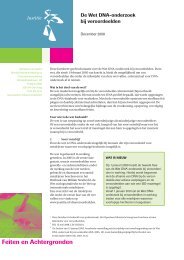INTERPOL HANDBOOK ON DNA DATA EXCHANGE AND PRACTICE
INTERPOL HANDBOOK ON DNA DATA EXCHANGE AND PRACTICE
INTERPOL HANDBOOK ON DNA DATA EXCHANGE AND PRACTICE
Create successful ePaper yourself
Turn your PDF publications into a flip-book with our unique Google optimized e-Paper software.
Summary• Training needs to distinguish between the responsibilities of the First AttendingOfficers and Crime Scene Examiner Specialists, and both require documentedprogrammes with clearly identified learning outcomes.• This training must link with the procedures/processes of the servicing <strong>DNA</strong>laboratory.• The training for the first responding officer must also include the normal first responseelements, not just the actions relating to <strong>DNA</strong> preservation.• The training for the crime scene examiner must include all actions required fora comprehensive and high-quality scene examination, and not be limited to <strong>DNA</strong>collection only.• This training must include understanding of <strong>DNA</strong> profiling capabilities andlimitations.• Training programmes should be competency-based, with a formal assessmentresulting in a formal authorization, thus allowing the individual to perform the workof which he has successfully demonstrated a command.• This training should be included in some form of accreditation programme or meetequivalent standards set for general-duties police scene attendance.•laboratory analysisThe laboratory must have fully documented training procedures and methods whichprescribe Quality Assurance (QA) requirements that are to be understood and metin the analysis programme generally, and in the practice of <strong>DNA</strong> profiling particularly.Training of laboratory personnel should be assessed formally and staff should beauthorized to perform the various aspects of the <strong>DNA</strong> profiling process for which theyhave been trained. It is up to each country/jurisdiction to formulate the actual contentof these programmes and the guidelines to apply thereto.•international standardsThere are also well-established international standards for the conduct of forensic<strong>DNA</strong> profiling. These relate to the physical requirement of separate critical steps of theprocess. Laboratory staff must be made aware of these standards in their training toensure a uniformly high quality of <strong>DNA</strong> profiling reliability.The sections of forensic accreditation programmes referring to the procedures fordealing with other types of evidence should also be adhered to. These points shouldbecome essential parts of the training process. Some of these points relate to thequalifications of staff undertaking certain functions, the ongoing training and developmentof laboratory staff, and the QA critical requirements for proficiency testing, bothinternal and external. The intimate connection between training requirements and QArequirements is evident here; adherence to these accreditation standards should be anintegral part of the training programme for forensic <strong>DNA</strong> laboratory personnel.PAGE 46TRAINING







